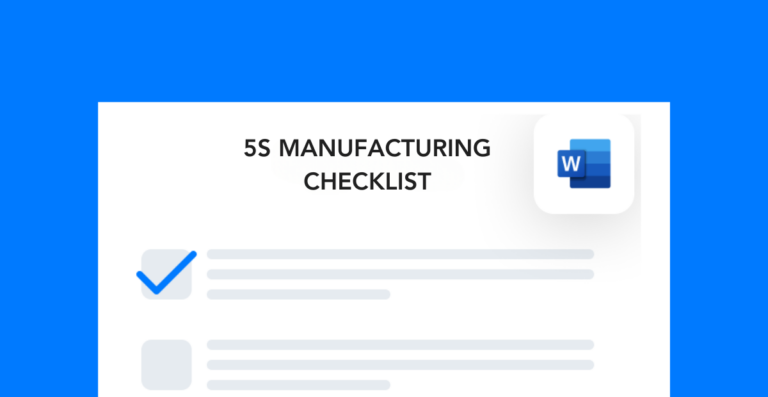There are three main sources of manufacturing costs: equipment, facilities, and people. You need to do routine audits of these areas if you want to keep expenses low and efficiencies high. Here are some ideas for reducing costs by tackling operational processes and equipment.
Free checklist!
Download this checklist to review the 5S in your manufacturing facility and make improvements, potentially lowering your overall manufacturing costs.
Equipment and technology manufacturing costs
In manufacturing, the use of outdated equipment is rampant. But have you ever considered how the technology you use affects your profits and the related manufacturing costs?
One of the most effective ways to lower costs is to invest in the right technology for each task and to maintain it properly. Moreover, the value of technology goes beyond the cost of constant upgrades or replacements. It also directly influences worker experience and overall efficiency.
Broken, damaged, or inefficient tools raise the risk of safety incidents and quality errors. In addition, they slow productivity and damage employee morale. Therefore, companies that prioritize reliable and modern technology can reduce long-term expenses while protecting both workers and output quality.
Here are eight practical ways to reduce the long-term costs of poor manufacturing equipment and outdated technology:
- Upgrade to action tracking software to reduce time spent on administrative tasks.
- Install machine guards on any dangerous equipment that has caused an incident.
- Perform year-round maintenance to increase your equipment’s lifespan.
- Rent or lease the equipment that you only need for a limited time.
- Schedule downtime to perform efficiency checks and fix any issues.
- Keep an equipment log so you won’t lose and replace items as often.
- Establish backup procedures to prevent major operational downtimes.
- Install security cameras to reduce the impact of loss prevention incidents.
Facilities and maintenance
Manufacturing facilities require constant upkeep and repair to remain efficient. And they come with a lot of recurring costs that can go unnoticed and unmanaged. Try some of these ideas to reduce and eliminate facility maintenance costs effectively reducing overall manufacturing expenses:
- Install motion sensor lighting to reduce utility use during downtime.
- Declutter your facility to both prevent incidents and to make it easier to clean.
- When renovating an area of the facility, opt for energy efficient materials.
- Create a repair station where workers can take damaged tools to be fixed.
- Shop for better deals on bulk items like paper goods, cleaning supplies, and PPE.
- Review your facility’s 5S to find more efficient layouts and organizational systems.
- Inspect the entire facility for structural issues that may increase utility costs and impact your bottom line.
Even the smallest changes can have multiple cost-reducing impacts. Take the idea of reorganizing a workspace to make it more efficient. This one project can reduce the throughput time of a process and cut down on the amount of rework due to errors. It can also improve ergonomic conditions and storage to prevent injuries and reduce time spent managing supplies.
The next time you do a facility audit, look for projects that improve multiple areas of efficiency at the same time, thus lowering manufacturing costs.
Staffing and human resources
Payroll is one of the biggest expenses in any company. But the costs of your workforce go beyond wages and benefits. They also come from other personnel management processes like recruiting, hiring, onboarding, and keeping workers engaged, all contributing to manufacturing costs.
Here are a couple of ways you might consider reducing costs through your HR department:
- Keep contact information of qualified job candidates for future position openings.
- Reassess market rates for all positions at least once a year to reduce turnover.
- Take advantage of seasonal staffing if your business is cyclical.
- Consider hiring contract employees to complete major structural projects.
- Implement an employee engagement program to avoid turnover.
- Use remote learning options to shorten the time it takes to onboard employees.
In manufacturing, finding ways to streamline onboarding and training is the best way to cut costs. This means investing in a learning management system to track training, improving the quality of your training content, teaching managers how to be effective instructors, and more.
Don’t forget to ask your employees for feedback when looking for improvement opportunities. They can always offer a unique perspective and provide commentary on any plans you may have. This is the surest way to find unexpected sources of manufacturing costs and make lasting improvements to performance.





